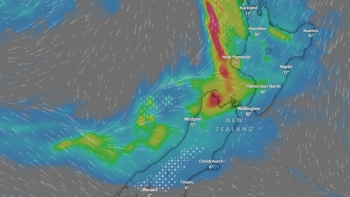Apple fans were eagerly watching the company's "Unleashed" event to see which rumours about the new MacBook Pro were true.
Most of them were, which got the thumbs up from commentators as it added a "notch" and an M1 processor and jettisoned the Touch Bar.
The headline take: Practicality was back, and bleeding-edge features for the sake of them were out.
"MagSafe, SD, and HDMI are back, Touch Bar is gone. Apple has abandoned a whole era and is giving Pro users what they want instead of what it thinks they should want," FastCompany tech editor Harry McCracken posted as he watched the virtual event.
"Between all the useful features returning to the MacBook Pro and the iPhone 13's willingness to be a little chunkier in order to deliver better battery life, Apple is showing an admirable ability to abandon seemingly cherished principles that went too far."
The most obvious change for the redesigned MacBook Pro - available in 14-inch and 16-inch models - is the new iPhone-style "notch" at the top of its display, which houses a 1080p webcam.
The bezels that border the screen are now just 3.5mm - or 24 per cent thinner than the previous MacBook Pro on the sides, and 60 per cent thinner along the top. The macOS menu bar now wraps around the camera.
The camera dose not support Face ID - a wishlist item for many - but there is a Touch ID sensor for fingerprint login.
The other main design change is the elimination of the Touch Bar, which is replaced by physical function keys.
And in addition to a MagSafe 3 power connector, each MacBook Pro includes three Thunderbolt 4 ports. A full-side SD card slot, an HDMI port, and a good old-fashioned 3.5mm headphone jack.
Pundits said the boosted connectivity options, and the return of the 14-inch display meant the Pro was, for the first time in years, clearly distinct from the Air.
Under the bonnet, the MacBook Pro gets Apple's M1 processor, which first appeared in the company's entry-level Macs a year ago. The Pro models get the souped-up M1 Pro and M1 Max, however.
Apple says both chips are twice as fast as the previous-generation Core i9 MacBook Pro at CPU-bound tasks. The M1 Pro is up to 2.5 times faster at GPU tasks, while the M1 Max is up to four times faster.
The new MacBook Pro models are also the first to feature the Liquid Retina XDR display first developed for the iPad Pro.
NZ pricing for the new 14-inch MacBook Pro model starts at $3399 (with education pricing from $3139) while the 16-inch model starts at $4299 (with education pricing from $3949.
Online orders open from today, with the new models in-store at "selected resellers" from October 26.
/cloudfront-ap-southeast-2.images.arcpublishing.com/nzme/3U4RYKHGRIFACVETI6ZSSND34Q.jpg)
The third-generation AirPods. (Photo / Supplied)
New AirPods, new smart speakers
Apple also revealed its third-generation AirPods today. A new design features a shorter stem, taking them closer to the AirPods Pro.
The new AirPods also gain the AirPods Pro's force sensor.
And the AirPods are now officially IPX4-rated for sweat and water resistance.
Apple says the battery life is six hours and up to 30 hours when including the charging case - compared to five and 24 hours, respectively, on the second-gen model.).
There's no support for active noise cancellation. For that, you still have to step up to the AirPods Pro ($449).
The third-generation AirPods will be available from October 26 for $329.
The second-gen model will remain on sale with its price falling to $239.
Cheaper, no-frills Apple Music plan
Apple also previewed its new Apple Music Voice Plan, which will work only via Siri and cost $7.49 per month and will be available later this year.
Apple says for access to its premium offerings, including Spatial Audio and Lossless Audio, Lyrics, Music Videos and more, subscribers will need an Apple Music individual plan ($14.99 per month) or a family plan with up to six accounts for $22.99 per month.
/cloudfront-ap-southeast-2.images.arcpublishing.com/nzme/66ZIQ6WTWRUD6WQJD37WQE4T7Q.jpg)
The new HomePod mini range. (Photo / Supplied)
The company also announced five new colours for its Homepod mini smart speakers, recently released here (read "Apple's HomePod mini smart speaker launches in NZ with a privacy edge over rivals").
Take your Radio, Podcasts and Music with you









